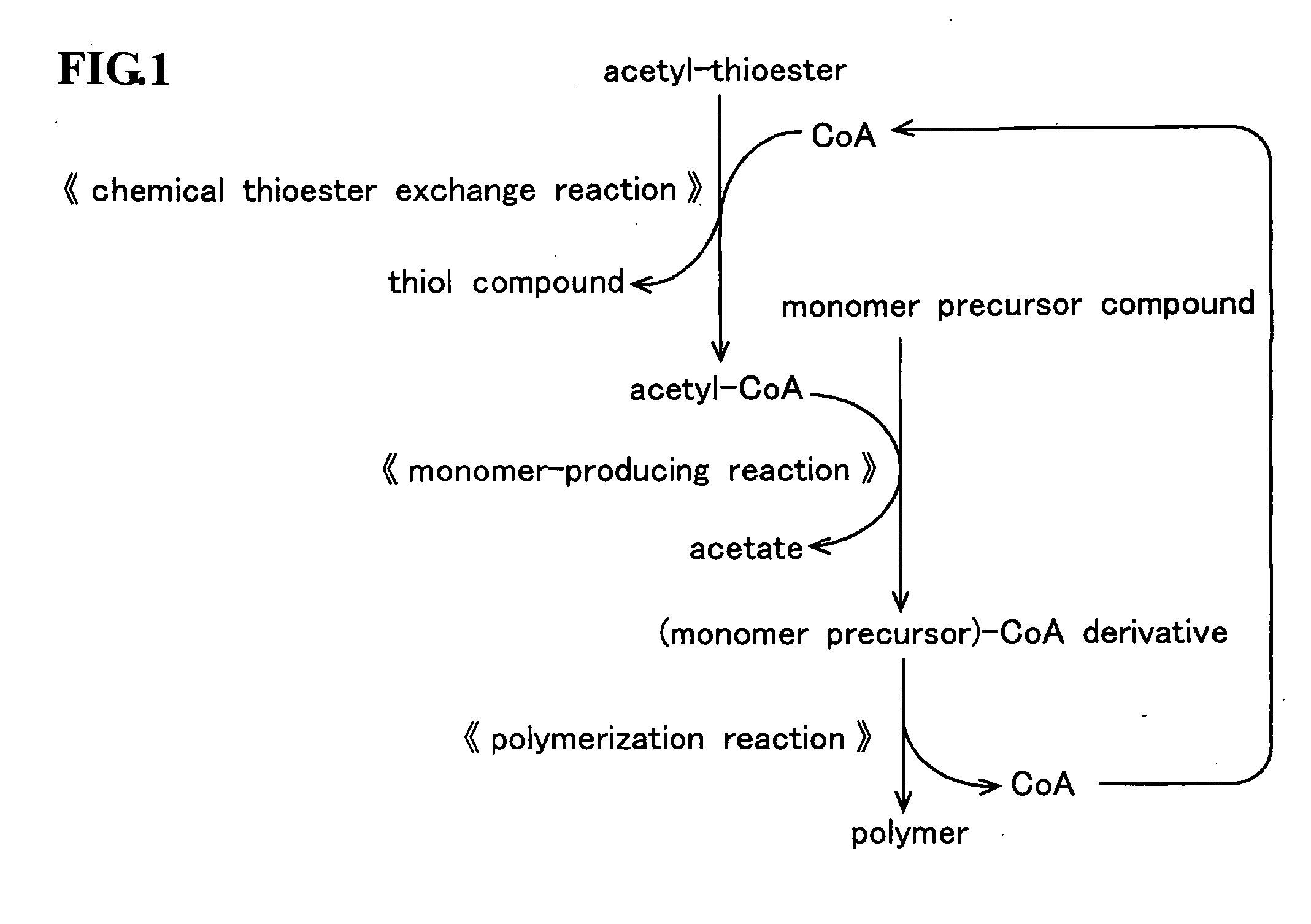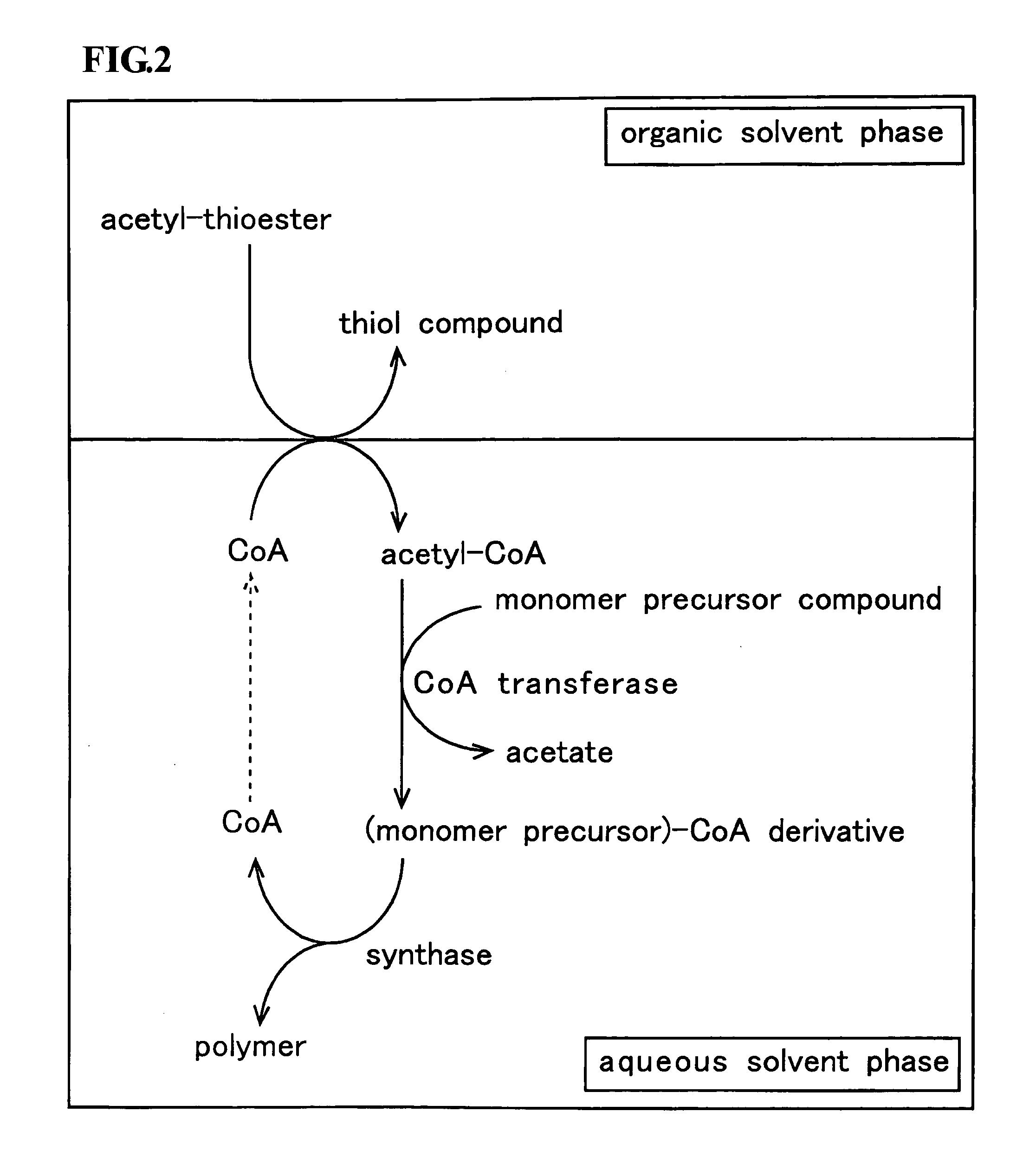Method for producing polymer
- Summary
- Abstract
- Description
- Claims
- Application Information
AI Technical Summary
Benefits of technology
Problems solved by technology
Method used
Image
Examples
example 1
[0082]In Example 1, a method for forming acetyl-thioester using acetate as a starting material to produce P (3HB) is described.
[0083](1) Production of Acetyl-Thioester
[0084]First, using acetate as a raw material, 2 types of acetyl-thioester (acetyl-TP and acetyl-ETG) were prepared [Yuan, W.; Jia, Y.; Tian, J.; Snell, K. D.; Müh, U.; Sinskey, A. J.; Lambalot, R. H.; Walsh, C. T.; Stubbe, J. Arch. Biochem, Biophys. 2001, 394, 87-98.]. FIG. 6 (1) shows the production process for acetyl-TP and FIG. 6 (2) shows the production process for acetyl-ETG.
[0085]It was confirmed that each substance obtained is esterificated by thin-layer chromatography (TLC) technique, using instrument of Merck Ltd. (Silica Gel F254). The overall structure was found by 1H-NMR spectrum, using nuclear magnetic resonance (NMR). In NMR measurement, MSL400 spectroscope of Brunker Corporation was employed, with a frequency of 400 MHz. All NMR spectra were recorded in deuterated chloroform (CDCl3) as the solvent, where...
example 2
[0107]In Example 2, P (3HB) polymerization reaction rate and production amount were discussed according to the type of acetyl-thioester.
[0108]As acetyl-thioester, acetyl-TP and acetyl-ETG were employed. In P (3HB) production process, P (3HB) polymerization reaction causes precipitate and makes the reaction solution cloudy. As the polymerization reaction is completed, the reaction solution becomes transparent, with white precipitates. Thus, the progress of P (3HB) production can be found from a visual observation and the turbidity in the reaction solution. The progress of P (3HB) production was measured from the turbidity in the reaction solution using an absorptiometer.
[0109]Specifically, 1.5 mL of an organic solvent phase reaction solution, a hexane solution containing 10 mM of acetyl-TP or acetyl-ETG was added to 1.5 mL of an aqueous phase reaction solution containing 100 mM sodium phosphate buffer (pH7.5), 10 mM (R)-3HB, 2.0 mM CoA and 7.5 U (0.3 mg) PCT. Finally, 1.6 U (0.06 mg)...
example 3
[0112]In Example 3, by changing the ratio of the concentration of the acetyl-ETG in the organic solvent phase and the concentration of (R)-3HB in the aqueous phase, the synthetic reaction rate for P (3HB) was discussed.
[0113]Firstly, a hexane solution containing 0.5 mmol acetyl-ETG was prepared as an organic solvent phase reaction solution, and 1.5 mL of solution containing 0.5 mmol (R)-3HB, 100 mM sodium phosphate buffer (pH7.5), 2.0 mM CoA and 7.5 U (0.3 mg) PCT was prepared as an aqueous phase reaction solution. By maintaining the acetyl-ETG amount in this organic solvent phase reaction solution and the (R)-3HB amount in the aqueous phase reaction solution at constant levels, the amount of the organic solvent phase reaction solution was changed. Specifically, the ratio of the volume of organic solvent phase reaction solution and the volume of the aqueous phase reaction solution was determined at 0.1:1 (indicated as □ in FIG. 11), 0.5:1 (indicated as ▴ in FIG. 11) and 1:1 (indicat...
PUM
| Property | Measurement | Unit |
|---|---|---|
| Brinell hardness | aaaaa | aaaaa |
| Brinell hardness | aaaaa | aaaaa |
| Concentration | aaaaa | aaaaa |
Abstract
Description
Claims
Application Information
 Login to View More
Login to View More - R&D
- Intellectual Property
- Life Sciences
- Materials
- Tech Scout
- Unparalleled Data Quality
- Higher Quality Content
- 60% Fewer Hallucinations
Browse by: Latest US Patents, China's latest patents, Technical Efficacy Thesaurus, Application Domain, Technology Topic, Popular Technical Reports.
© 2025 PatSnap. All rights reserved.Legal|Privacy policy|Modern Slavery Act Transparency Statement|Sitemap|About US| Contact US: help@patsnap.com



